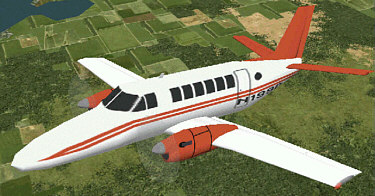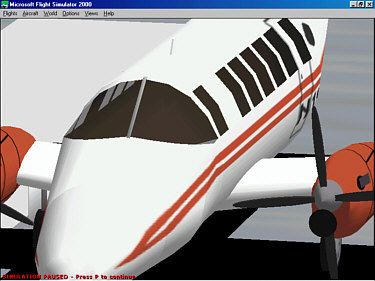
Creating a Canopy/Cockpit Section in FSDS
For this demonstration I used Chuck Dome's Beech 99 Airliner .FSC file found on flightsim.com.

| Step1 I deleted the old fuselage and then rebuilt a new fuselage being careful to add enough sections to duplicate the window/window frame structures.
|
Step
2 Next, I reshaped the sections around the windshield to fit the shape of the actual airplane.
|
| Step
2 (cont.) I continued to reshaped the sections being careful to not only move the points fore and aft but keeping the X scale correct. For example: If you move a pair of points up from the center of the fuselage, they will be further apart on the X axis than points next to them. Be sure to scale them to avoid unwanted "bumps" and "tumors".
|
Step
3 The next step is to correct the non-planar polygons that most likely occurred during the windshield reshape process. Note: I do not recommend performing the "Check Parts" function at this point. This will correct non-planar polygons for all parts even if there in not a display problem. This will cause the model to become much more complex than necessary. The solution: Save your project
to this point (and do a "Save As" so you have a backup
copy).
|
| Step
4 Open a new project and go to Part > Load and load "fuselage middle".
|
Step
5 Reopen your original project and delete the existing "fuselage middle" part. Next, delete the points from the original fuselage to "cut out" the section that will be replaced.
|
| Step6 Load the new corrected "fuselage middle" part back in.
|
Step
7 Go to the Part > Select by Name and select your fuselage and the fuselage middle. Notice that the two parts are now selected.
|
| Step
8 Go to Part > Join Selected to marry the two pieces back together.
|
Step
9 The next step is to create the windows. Again, copy and paste the fuselage onto itself. Delete all polygons EXCEPT where the windows are placed from the newly pasted fuselage. Be sure to edit the part properties to make it transparent or say "Uses Transparent Texture". Rename this part something like "windows".
|
| Step10 Do the OPPOSITE for the first fuselage. This created window cut-outs and windows that match perfectly.
|
Step
11 Build your project and take a look! Oops! Notice that you now have windows but you can see through the fuselage. We can fix this...
|
| Step
12 To fix the see- thru fuselage you need to create an inner skin. Copy and paste the fuselage onto itself once again. This time, eliminate the sections that will not be seen from the outside.
Next, go to Polygon Mode, then go to Edit > Select All then to Polygon > Flip All Selected.
Note: Select the points for the aft section and go to Polygon > Make Poly from Selected Points. this will create a solid bulkhead. You might have to flip this poly to get it to display correctly. Repeat for the fore bulkhead. |
Step
13 Rebuild you project and take a look! Now all that you're missing is the rest of the window framing and window textures.
|
| Step
14 Add a window frame from a square tube. Repeat the process to add the remaining frames.
|
 |
| Step
15 the next step is to create a transparent texture for the window reflection. Create a 256x256 BMP with two, three or more colors. I choose: Grey - to simulate runway reflection Light Blue - to simulate sky reflection White - to simulate bright sun reflection Then open the file in File > Make Transparent Texture... in FSDS.
|
Step
15 Here is where you can set the varying degrees of transparency for each color. To set the transparency for a
particular color, first click on the Set All button to clear any
previous settings.
|
| Step
16 Apply the texture the "window" part, rebuild your project, copy the texture to correct folder and view your final results!
|
Questions? Comments? Email me at: webmaster@daviator.com
©2000 David Eckert
